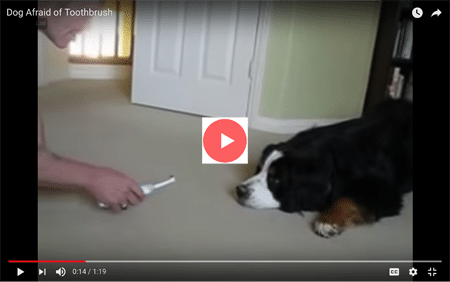
Click to see almost everything you DON’T want to do when brushing your pet’s teeth…all in a little more than a minute.
Although this video is guaranteed to give you a laugh, there’s nothing funny about dental disease in your pets. Let’s break down where this guy is going wrong, so you can get it right when you brush your pet’s teeth. We see at least 3 areas for improvement.
Don’t Start with an Electric Toothbrush
For that matter, don’t end up there, either. It would be very unusual if your pet wasn’t scared by a strange buzzing object such as this. If you’ve never brushed your pet’s teeth before, start by letting your pet lick a small amount of pet toothpaste from your finger. Do this daily for a week or two until your pet is comfortable with it. From there, move to a finger brush with pet toothpaste. After another week or two, you can move to brushing with a soft-bristled brush. A pet toothbrush will typically have a longer handle than a human toothbrush, but either will work just fine.
A NOTE ABOUT TOOTHPASTE: Only buy toothpaste that is made for pets. NEVER use human toothpaste on your pet. They can’t spit it out like we do, and swallowing it isn’t safe. Pet toothpaste is specially formulated to be swallowed safely. Not to mention, your furry friend will much prefer chicken- or liver-flavored pet toothpaste over minty freshness.
Don’t “Assume the Position”
Paws down and tail up is a classic “wanna play” position. When he approaches his dog in this position, this man is sending a strong signal that it’s play time. Then, when the dog reacts to that signal, the man gets frustrated. For a better, calmer experience, you and your pet should be roughly on the same level. If your dog is large, have him sit with you next to him. If you have a smaller dog or a cat, have the pet sit in your lap so their mouth is easily accessible.
A NOTE ABOUT RESTRAINT: Hold your pet gently to focus his attention, but do not restrain him. Restraint can contribute to panic and result in your pet becoming stressed during teeth brushing.
Don’t Chase a Nervous Pet
This video goes on for more than a full minute…and it probably only shows a portion of the whole experience. If your pet shows signs of nervousness like the dog in this video, such as running away, nipping, etc., back off and try again tomorrow. If you recently changed the process (such as moving from a finger brush to a pet toothbrush), go “backwards” a step for a week or two, then try again.
We are happy to answer any questions you may have about caring for your pet’s oral health. We can also recommend dental products that are safe and effective.

Recent Comments